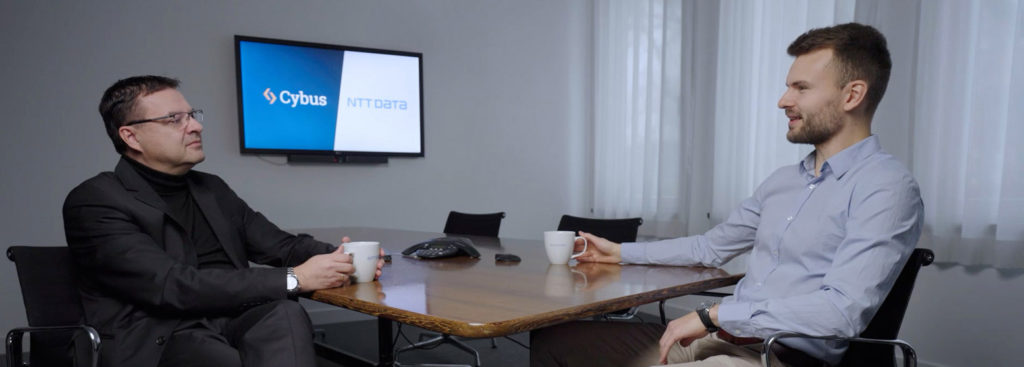-
-
Insights & knowledge
For users
Support
-
Ecosystem
About Cybus
This article about MES first appeared in DIGITAL MANUFACTURING Magazine (translated)
Many companies are facing major challenges in the transformation to data-driven production. Gero Adrian, Senior Management Advisor Manufacturing at NTT DATA, explains in an interview how the role of Manufacturing Execution Systems (MES) has changed in the industry and what alternatives companies have to establish a sustainable data architecture.

Digital Manufacturing (DM): What were the original functionalities of an MES?
GERO ADRIAN: An MES is a software that manages production orders and makes the associated specification data available for production. This production data is made available to higher-level IT systems such as ERP (Enterprise Resource Planning). It therefore optimizes production processes because it is a single source for specific manufacturing and production information. Over the last 30 years, however, the manufacturing environment has changed radically: As a result, the original idea of the MES as a monolithic software system is under great pressure.
DM: Is a conventional MES then still a smart investment for modern production processes?
GERO ADRIAN: In most cases, rather not. Because some MES functions are nowadays often taken over by the ERP system, for example with a planning board module or function modules such as SAP PCo. And data systems from the lower levels of the automation pyramid also already take over many MES functions. For example, there are now intelligent modules from robot manufacturers such as FANUC that bring their own machine data acquisition (MDA). For the digitization of the factory, the MES is thus left with only a few sub-elements of production planning that are tailored to the manufacturing process of the respective production.
“Data systems from the lower levels of the
Gero Adrian, Senior
automation pyramid are already taking over
many MES functions.“
Management Advisor Manufacturing, NTT DATA
DM: When does an MES in the original sense no longer fit today’s production processes?
GERO ADRIAN: I like to locate the different scenarios on a scale that describes the production complexity at the customer. Let’s first look at the less complex case of a pot manufacturer: In the case of a deep-drawn blank, the sequence planning goes through an ERP system. The blanks, the handles, the lids or the painting are done by robots and automated transport systems. Here, the process and planning depth is quite low due to the low number of production steps. A local system for data distribution, i.e. a local broker, is sufficient for this. This is very inexpensive, powerful and can be expanded quickly.
And then there are highly complex scenarios, for example the production of an automatic transmission. For assembly, 30 to 40 different machines are needed to assemble hundreds of individual parts. If this production is to be controlled by an MES, it takes about four months to link the MES to the machine line and set up the detailed planning. Once set up, this structure is very difficult to adapt.
To ensure continued flexibility and adaptation, for example to supply bottlenecks, we therefore recommend an event-driven architecture as an alternative. Here, all relevant components and structures are flexibly combined as required; for example, a new assembly order is supplemented with all information from MES and ERP. This means that the actual state changes in the process drive the business process. Technically, an enterprise-wide, global broker such as Kafka is suitable for this. The individual ‘events’, i.e. data objects, are processed according to the desired business logic and then flexibly distributed throughout the enterprise IT (CRM, PLM, ERP). This breaks the rigid ISA 95 model. In these cases, the MES is not only obsolete, it would even be the worse choice.
“Some MES solutions are already more than 25 years old.
Gero Adrian, Senior
You can’t build a smart factory on that.“
Management Advisor Manufacturing, NTT DATA
DM: So you’re proposing a local middleware and a global broker. Why?
GERO ADRIAN: Some MES solutions are already more than 25 years old and are based on dedicated application and database servers and use CSV files in data exchange – a technology of the last millennium. You can’t build a smart factory on that. If a roll-out mechanism is required down to the control level in production, it should be based on Infrastructure-as-Code. This is the only way to automate rollouts. In addition to data security and cybersecurity, bidirectional data processing is also indispensable. When job data is sent to production, feedback from the machine should be possible. To ensure fail-safety, the software should also be cluster-capable. The majority of products on the market do not cover all of this.
DM: Can you give us an example of why these characteristics of an infrastructure are important?
GERO ADRIAN: Today, many customers have to face the problem of disrupted supply chains. Raw materials or even components such as screws cannot be delivered. Nevertheless, manufacturers have to meet the orders. They are only able to effectively do so if they become incredibly flexible in allocating their customer orders. If they have the right data infrastructure, they can ‘pre-process’ with the materials they already have, i.e., finish the basic elements first. Certainly that would not be possible with very rigid manufacturing processes. Many of our customers now have this flexibility and the technologies to do it: with middleware like Cybus Connectware (a global data broker), real-time data, cybersecurity and resilience. They are also making their production visible in real time, including insights into production returns. This is particularly relevant to the CFO.
DM: Why does the CFO benefit from this flexible solution without MES?
GERO ADRIAN: CFOs can use real-time data to map the financial flow and financial availability of the factory. They integrate live data into their reporting and can provide clear benchmarks to make controlling more efficient. In addition this would give them detailed insights into production – rather than an Excel spreadsheet that can’t be analyzed until months after the data is collected. And in the future, measuring CO2 consumption with the help of reference current analyses and energy consumption measurement of the machines will also be unavoidable. This can no longer be done with extrapolations – real energy figures are needed for this. In the automotive industry, this is already mandatory. So our customers are well prepared to prove their CO2 consumption.
DM: Mr. Adrian, thank you very much for the interview!

In interview: Gero Adrian, Senior Management Advisor Manufacturing at NTT DATA.

The interview was conducted by Danny Rybakowski, Head of Partner Management at Cybus.
NTT DATA is Trusted Global Innovator of Business and IT Solutions, headquartered in Tokyo. We support our customers in their transformation through consulting, industry solutions, business process services, IT modernization and managed services. With NTT DATA, customers and society at large can move confidently into the digital future. We are committed to our customers’ long-term success, combining global presence with local customer support in over 50 countries.
You need to load content from reCAPTCHA to submit the form. Please note that doing so will share data with third-party providers.
More InformationYou are currently viewing a placeholder content from Facebook. To access the actual content, click the button below. Please note that doing so will share data with third-party providers.
More InformationYou are currently viewing a placeholder content from Instagram. To access the actual content, click the button below. Please note that doing so will share data with third-party providers.
More InformationYou are currently viewing a placeholder content from X. To access the actual content, click the button below. Please note that doing so will share data with third-party providers.
More Information